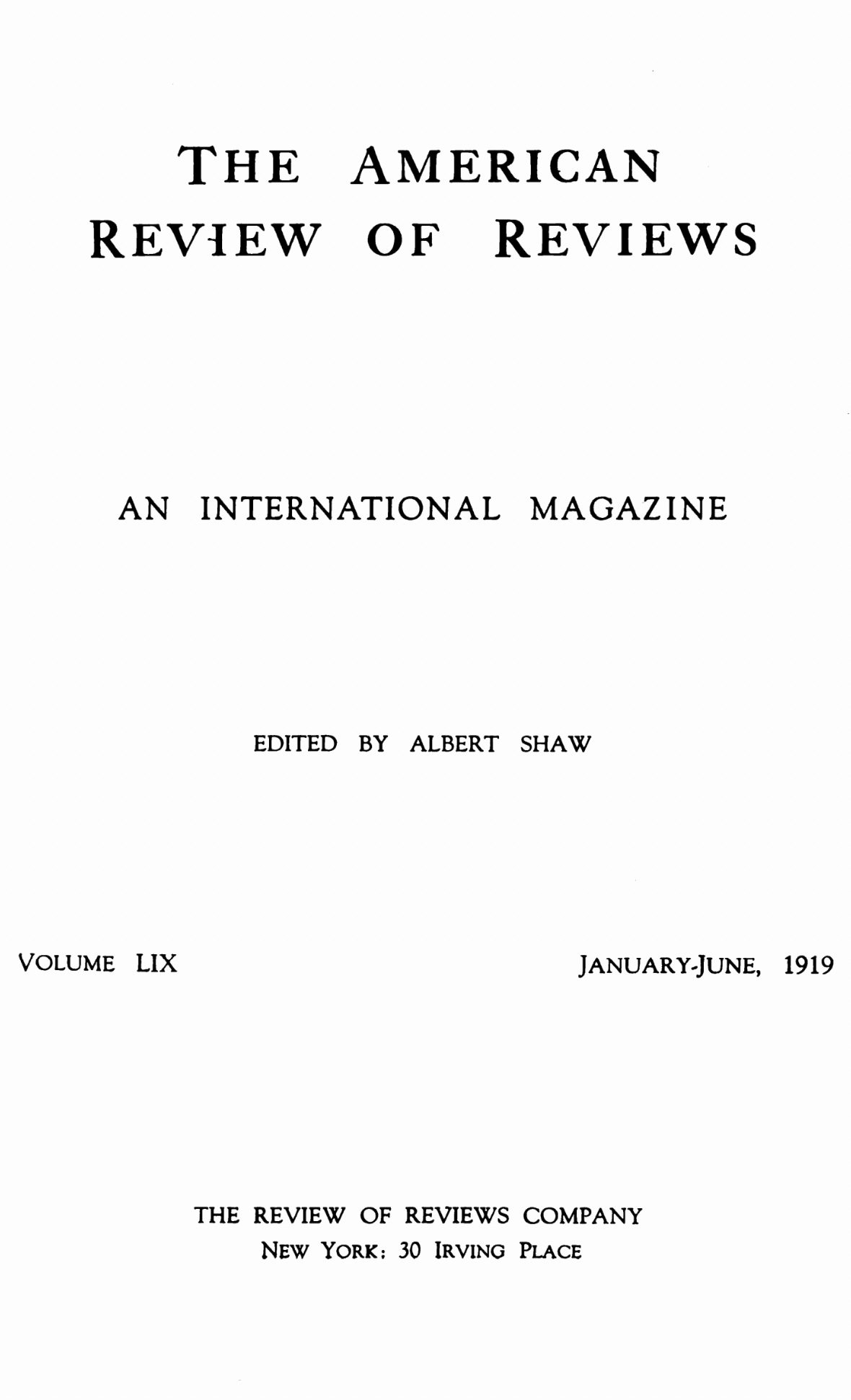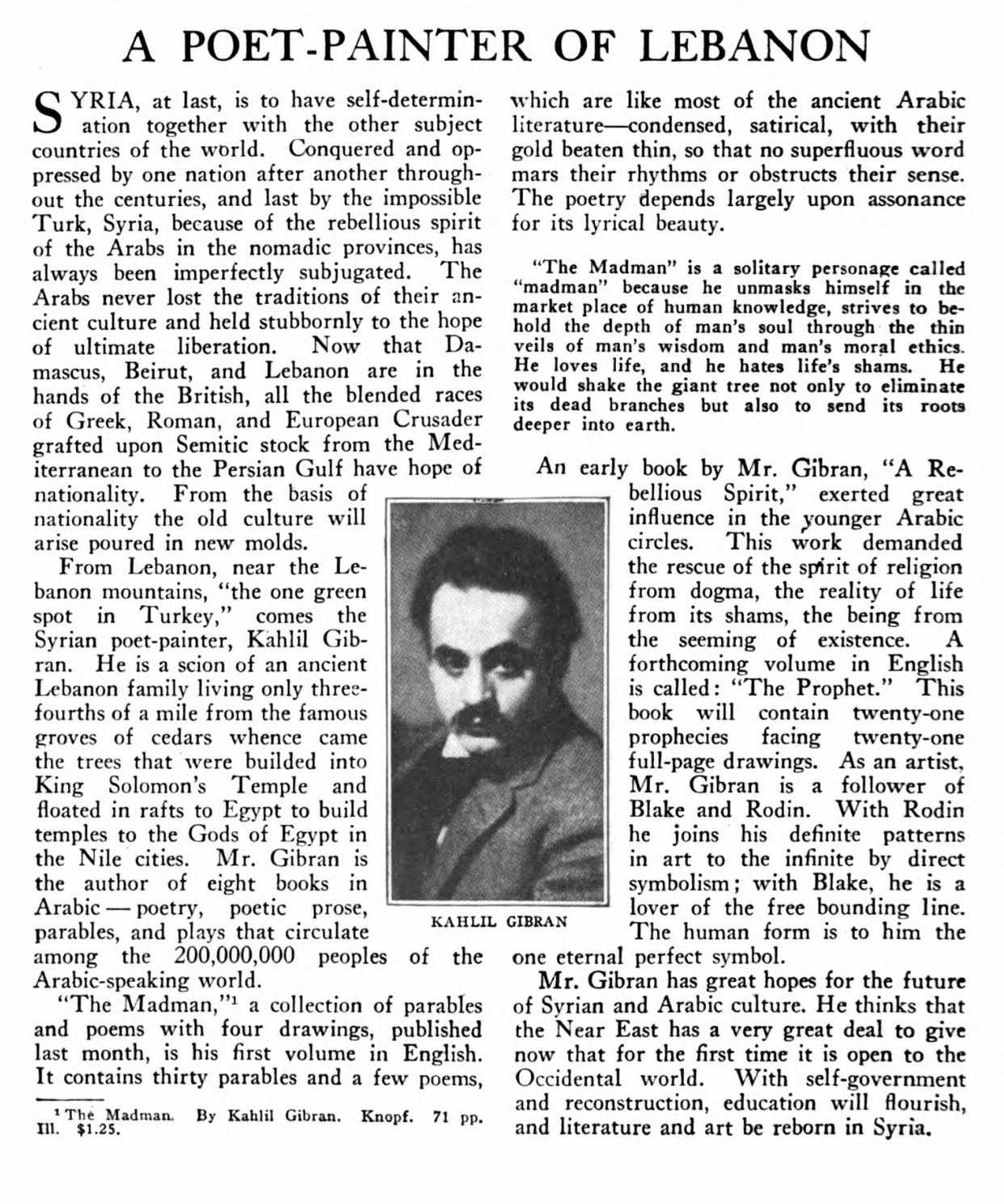-
-
-
-
Search
-
-
0
-
Shopping Cart
xProducts:0Cart Empty
-
by Philippe Maryssael, retired translator and terminologist, translator of Kahlil Gibran and contributor to the Kahlil Gibran Collective – Arlon, Belgium, July 6, 2025 – All rights reserved copyright © 2025.
 While searching for information with a view to preparing a book on all of Kahlil Gibran's illustrations from his writings in English, Glen Kalem-Habib and I have dug up a short, two-column article titled A Poet-Painter of Lebanon. That article lay buried on page 212 of a 688-page thick publication, Volume LIX (59) of The American Review of Reviews, An International Magazine edited by Albert Shaw, covering the period from January to June of the year 1919.
While searching for information with a view to preparing a book on all of Kahlil Gibran's illustrations from his writings in English, Glen Kalem-Habib and I have dug up a short, two-column article titled A Poet-Painter of Lebanon. That article lay buried on page 212 of a 688-page thick publication, Volume LIX (59) of The American Review of Reviews, An International Magazine edited by Albert Shaw, covering the period from January to June of the year 1919.
The Review of Reviews was a noted family of monthly journals founded in 1890–1893 by the British reform journalist William Thomas Stead (1849–1912) who, as a pioneer of investigative journalism, became a controversial figure of the Victorian era.
Established across three continents in London (1891), New York (1892) and Melbourne (1893), The Review of Reviews, The American Review of Reviews and The Australasian Review of Reviews represented Stead's dream of a global publishing empire.
Stead was most famous in Britain for having passed, almost single-handedly, the first child-protection law by investigating and reporting child vice and white slavery in a series of articles titled The Maiden Tribute of Modern Babylon, published in The Pall Mall Gazette in July 1885. As a result, the Criminal Law Amendment Act 1885 raised the consent age for girls from thirteen to sixteen, similar to "statutory rape" laws in the United States.
As editor of the London Pall Mall Gazette (1883–1889), Stead caused newspapers to appear the way they are today. He introduced crossheads (section titles) and signed articles, popularised interviews, and started illustrations and indexing. An advanced feminist, he was the first London editor to pay women equally with men.
He authored many books, including The Truth about Russia (1888), If Christ Came to Chicago (1893), and The Americanization of the World (1902). His essay How the Mail Steamer Went Down in Mid Atlantic (1886) is considered his first prediction of the sinking of the RMS Titanic; his novel From the Old World to the New (1892) was the second prediction. Stead himself died in the sinking of the Titanic in 1912.
The Review of Reviews was started in January 1890 by W.T. Stead and Sir George Newnes (1851–1910).
The Review mirrored Stead's own over-active imagination and was written almost exclusively by him. Along with the dozens of magazine and book reviews it contained, it also included a running commentary of world events, entitled The Progress of the World, and a character sketch of a current "celebrity." The first issue was an instant success. However, Stead's relationship with Newnes came under strain when the latter strongly objected to Stead's scathing character sketch of The Times newspaper.
Perhaps seeing this discord as a sign of things to come, Newnes severed ties, exclaiming that the whole venture was "turning his hair grey." After buying out Newnes's share, Stead shaped The Review after his own image. With article titles such as "Baby-killing as an Investment" and "Ought Mrs. Maybrick to be Tortured to Death?", Stead showed he had lost none of the sledgehammer force of his journalistic days. He also involved The Review in social work, setting up the Association of Helpers and even an adoption agency called The Baby Exchange.
In 1891–92, Stead founded the equally successful American and Australian editions of The Review, and, in London, he added to his success with other literary triumphs, such as book series The Penny Poets, Popular Penny Novels and Books for the Bairns, all published under The Review's auspices. However, in spite of such apparent successes, without the business-like Newnes to guide him, Stead frequently drove The Review to death's door.
The American Review of Reviews was edited by Albert Shaw (1857–1947), an American journalist, academic and reformer.
Published from New York, The American Review of Reviews ran simultaneously alongside its British counterpart.
Shaw was part of the first generation of academic reformers, which included his classmate at Johns Hopkins University, Woodrow Wilson (1856 –1924), who was the 28th president of the United States, serving from 1913 to 1921.
The American Review of Reviews is one of the best primary sources on American reform between 1890 and 1920, providing not only a panoramic view of the range of reformers' interests, but also the ties between British and American progressives. By volume 3, however, its style had departed significantly from that of its British cousin.
The American Review of Reviews ran until 1937, when it merged into The Literary Digest.
 The article on Kahlil Gibran from the 59th volume of The American Review of Reviews starts with some considerations on the self-determination of the nations of the Levant after the dismantlement of the Ottoman Empire in the wake of Germany’s defeat after World War I. A few details are then given on what Mount Lebanon was famous for in biblical times: the cedars that were used in the construction of Solomon's Temple and numerous Egyptian temples to the Gods of Egypt in the Nile cities.
The article on Kahlil Gibran from the 59th volume of The American Review of Reviews starts with some considerations on the self-determination of the nations of the Levant after the dismantlement of the Ottoman Empire in the wake of Germany’s defeat after World War I. A few details are then given on what Mount Lebanon was famous for in biblical times: the cedars that were used in the construction of Solomon's Temple and numerous Egyptian temples to the Gods of Egypt in the Nile cities.
Then comes Kahlil Gibran, the author of books of "poetry, poetic prose, parables and plays in Arabic." His Madman is described as "a collection of parables and poems with four drawing, published last month, [being] his first volume in English." This indicates that the article on Gibran must have been written in October 1918 and compiled in the 59th volume of The American Review of Reviews almost a year later.
What is quite interesting about this article is the fact that "[a] forthcoming volume in English is called: 'The Prophet.' This book will contain twenty-one prophecies facing twenty-one full-page drawings." Time has passed and we know that The Prophet contains not 21 but 28 counsels and not 21 but 12 drawings and paintings. This may indicate that Gibran’s masterpiece got transformed over time, from the earlier project to the published book that we know and cherish today.
Source: most of the details on The Review of Reviews is based upon the Wikipedia article.
Courtesy of the Kahlil Gibran Collective, the article is made available to you in its entirety in the KGC archive.
Information on Philippe Maryssael’s publications can be found at http://www.maryssael.eu/en/.